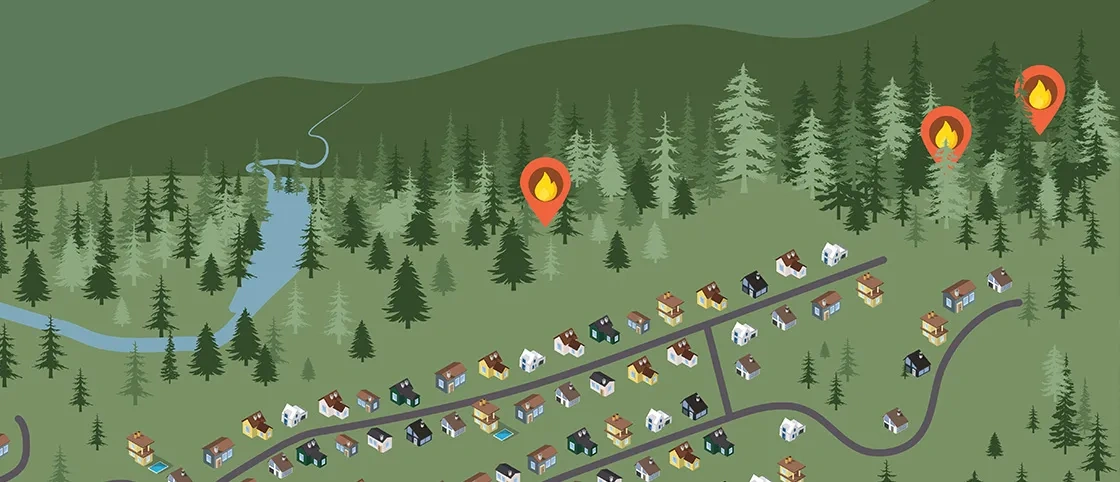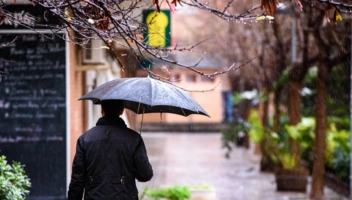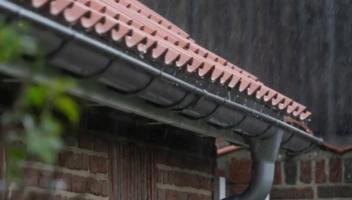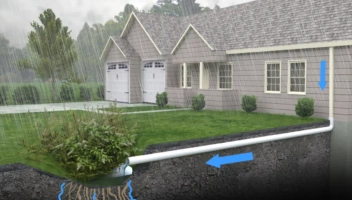May Is Wildfire Awareness Month: Protect Your Home From Wildfires

As summer approaches and the temperatures rise, it’s important to be aware of potential fire hazards. May is Wildfire Awareness Month, an excellent time to prepare and protect your home from wildfire dangers. From creating a defensible space around your residence to hardening your home, several precautions you can take now will help protect your home from wildfires.
Read to learn how you can safeguard yourself and your home against wildfire.
When Is Wildfire Season?
Wildfire season in the United States varies by region, but it typically runs from late spring (May) through to the fall (October). During these months, conditions such as low humidity, high temperatures, and high winds make it easier for fires to ignite and quickly spread.
The risks of these fires can be further compounded by droughts and dry lightning strikes, which can be devastating in a matter of seconds. It is crucial for people living in wildfire-prone areas to understand when fire season is and the risks associated.
Where Do Wildfires Occur?
Historically, Alaska, Arizona, California, Colorado, Idaho, Montana, New Mexico, Nevada, Oregon, Utah, Washington, and Wyoming have suffered the most devastating wildfires. But wildfires can happen in a variety of settings.
These fires are prevalent in dry, hot, and often windy areas. While trees, brush, and grasses can act as a fuel source, helping these fires spread quickly and unpredictably. That’s why it’s essential to understand the risk of wildfires in your area: rural, suburban, or urban setting.
Prepare Your Home for Wildfires
As wildfires become more common and unpredictable, preparing your home in advance is essential. You can start by taking the necessary steps to protect your property and loved ones.
- Start by creating a defensible space around your home. Clear out any brush, debris, or dry wood in a 30-foot perimeter. Ensure gutters are clear of any fire-prone debris and vegetation.
- Equip your home with smoke detectors for early warning. And have an emergency evacuation plan.
- Remember to pack a “go bag” with essential documents, prescriptions, pets, and insurance information in case you need to leave your home quickly.
Don’t wait until it’s too late. Prepare your home for wildfires today to keep yourself and your family safe.
How to Protect Your Home From Wildfires
Create a Defensible Space
Creating a defensible space around your home is crucial for the safety of your property and loved ones. This space acts as a barrier that can slow or even stop the spread of a fire, giving firefighters a chance to protect your home.
- REMOVE any dead or dry vegetation within 30 feet of your home, including leaves, needles, and branches
- THIN OUT any live vegetation to reduce the amount of fuel available to a fire
- ENSURE all tree branches are at least 10 feet away from your roof
- CLEAR any combustible materials like firewood or propane tanks away from your home
By creating a defensible space, you’re taking an important step to protect your family, property, and community.
Defensible Space Zones
California law requires residents to adhere to designated zones 1 and 2 when assembling a defensible space. While not required by law, zone 0 protects against flying embers. Even if you don’t live in California, this is a great reference when creating your own defensible space.

- Zone 0 – Ember-Resistant Zone
Extends 0–5 Feet from the Home Structures - Zone 1 – Lean, Clean, and Green Zone
Extends 5–100 Feet from the Home Structures - Zone 2 – Reduce Fuel Zone
Extends 30–50 Feet from the Home Structures
Harden Your Home Against Wildfires
Taking the necessary steps to harden your home can help increase the chances of it surviving a wildfire.
Exterior of the Home
- Roof
The roof is the most vulnerable part of the home. Build or repair your roof with non-combustible materials such as composition, metal, tile, or clay. Replace eaves with short overhangs or soffit-eave designs composed of fire-resistant or noncombustible materials to reduce embers on the roof from causing fires.
- Vents
Wind-blown embers pose an extra risk to open vents. Cover all vent openings with metal wire mesh between 1/16 inch to 1/8 inch.
- Windows
Intense fire heat can cause windows to break before a fire has reached the home. Single-pane and large windows are most susceptible to fire damage. Install multi-pane windows, tempered glass, or fireproof shutters to reduce the chance of breakage.
- Wall Coverings
Popular siding materials, including wood products like shutters and shingles, are flammable and not a good choice for fire-prone areas. Instead, use ignition-resistant materials such as stucco, treated wood, fire retardant, and fiber cement wall coverings.
- Rain Gutters
Debris can quickly gather and clog gutters increasing the risk of catching fire from flying embers. While keeping your gutters clear or covering them will prevent the accumulation of debris.- Investing in a noncombustible gutter guard, like LeafFilter, will prevent the buildup of debris and vegetation in your gutters.
- Address, Driveways & Access Roads
Help firefighters and emergency responders quickly find and access your property.- Ensure street signs and your address are clearly visible.
- Build driveways and access roads following state and local codes.
- Trim overhanging trees and shrubs and install gates to open inwardly to allow emergency vehicles to pass.
- Water Supply
Plan and install water sources near your home and additional structures. Long hoses should be able to reach any area of the house. External sprinkler systems and water tanks are also great options. Additionally, you can fill garbage cans, barrels, tubs, and other large containers with water.
Inside Your Home
Review Your Insurance Policy
Check homeowner insurance policy and verify wildfire coverage can help you file a claim in the future and support you financially until you get back on your feet.
Prepare a List of Your Home’s Contents
Documenting all of your belongings will help you when filing any insurance claims. In addition to creating a list, consider documenting your content visually. You can take pictures or walk through your home and take video of your belongings.
Click to access a complete Wildfire Home Retrofit Guide funded by CAL FIRE.
Fire Smart Landscaping – Protect Home From Wildfire
Investing in fire-smart landscaping is crucial today when wildfires are becoming increasingly common. Go beyond a well-maintained yard. Homeowners can significantly reduce the risk of damage or destruction from wildfires by incorporating fire-resistant plants, creating strategic defensible spaces, and utilizing appropriate irrigation techniques.
No Plant is 100% Fire-Resistant
You may see some plants advertised as ‘fire-resistant,’ but all plants will burn under the right conditions. Additionally, the environment a plant grows and how it is maintained will significantly impact its flammability.
Plants naturally containing resins, oils, or waxes are most prone to catching fire and should not be planted near structures. Do not place conifers and most ornamental grasses, which are highly flammable, within 30 feet of structures. Finally, remove cypress, arborvitae, rosemary, eucalyptus, and ornamental juniper from zones 0 and 1 to protect your home from wildfires.
Drought-tolerant & Fire-resistant Plants
Having a well-maintained fire-resistant yard doesn’t mean you have to sacrifice your home’s aesthetic. Look for plants high in moisture content, deciduous trees, and slow-growing plants, such as:
- Aspen
- Cherry
- Fescue
- Honeysuckle
- Rose scrubs
- Dalea
- Evening primrose
- Texas ebony
Get more fire-smart landscaping tips here.
In Conclusion
Taking the appropriate steps to protect your home from wildfires is paramount. Preparing your home, creating defensible space between your property and vegetation, and hardening your home against wildfire is essential.
LeafFilter’s triple-level protection can help protect your home against wildfire damage. Its noncombustible micro-mesh screen keeps debris and other combustible materials from clogging your gutters which can cause flames to spread quickly. This additional security adds a layer of defense against a danger no homeowner should be without.
Learn more about LeafFilter today to secure a safer tomorrow for you and your family!


